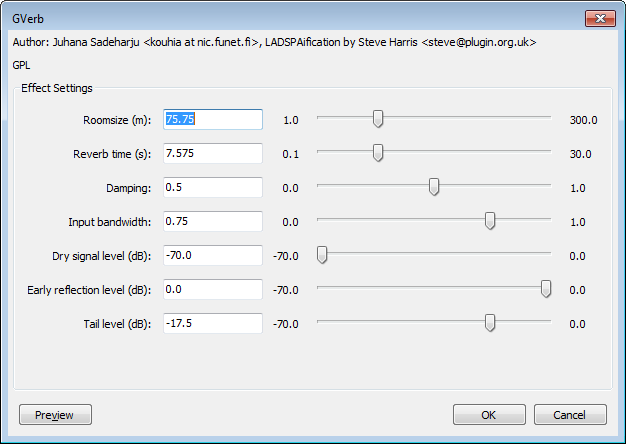GVerb
From Audacity Manual
GVerb is a free GPL reverberation plug-in, originally written by Juhana Sadeharju then ported to LADSPA by Steve Harris.
- For a quick and very strong reverb, try changing the "Early reflection level" and "Tail level" values slightly. You may need to use to decrease the audio level before applying the effect.
- For more configurable reverb, GVerb is best used by selecting the track to be reverbed, then . Apply GVerb to the duplicated track, then play the original and duplicated track together, using the gain slider on each track to reduce each track's volume by greater or lesser amounts. This gives you a quick and flexible way to vary the strength of the effect.
- To prevent an abrupt "cut off" of the reverb at the end, it is recommended to use at the end of the region to be reverbed, then include the inserted silence when applying GVerb.
Roomsize
Controls the overall characteristics of the reverb effect. In general, this parameter influences both the simulation of early reflections and the sound of the tail.
Reverb time
Controls the approximate duration of the reverb floor. In general, this parameter affects the simulation of the reverb tail. Very small settings cause the tail to almost disappear.
Damping
This parameter controls the response of the early reflections and the decay of the reverb tail. The higher the value, the less intense is the reverb.
Input Bandwidth
Provides some kind of "tone" control. Small values cause a smaller frequency range to be processed. In general, the effect of this control can be heard in the treble band. Smaller values cause a "muffled" and less bright reverb.
Dry signal level
A volume control that determines the amount of original sound in the reverb. The default -70 dB produces very little dry signal, and so a very strong effect.
Early reflection level
A volume control that determines the amount of early reflections. Early reflections are similar to "slapback" echoes. Though they are not responsible for the typical "hall" effect generally linked with reverb, they contain lots of acoustic information about the environment in which the sound occurs.
Tail level
A volume control that determines the amount of the "hall effect" of the reverb. The volume of the tail determines how intense the reverb appears to be.
